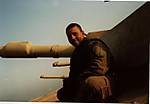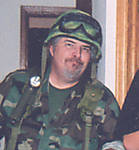I think that I would submit at this point in the discussion that we should perhaps look at all landscaped model art as forming a continuum that is something analogous to a similar continuum of paintings.
In my opinion, some landscaped model art works are the compositional equivalent of portraits, some are composed like landscapes, and still others are composed like Don Troiani action paintings of epic battle scenes (or other events with high drama).
Don Troiani Prints I would call the first kinds, landscaped works that are the compositional equivalent of portraits, vignettes. There is clearly no intent to "tell" a story, but the modeler can still create an aesthetic that can evoke feelings and emotions in the viewer, even if those feelings are as simple as an appreciation of and emotional response to the beauty and appeal of the subject and its presentation.
I would also categorize most landscaped works in the second group, the ones that are composed like landscapes, vignettes. Again, there is usually no clear story (often the builder has intended a "story" but has failed), but here we have more compositional elements and the landscaped portion of the work takes on greater significance and role. Once again, though, the work can be appreciated for its aesthetic qualities, which again can evoke emotional responses in the viewer, but if the work still lacks the qualities of drama and storyline, then it is, in my book, a vignette.
Then we have the final group, those dioramas that are composed like paintings that illustrate drama and story. These works are, in my world, true dioramas (no need to "gild the lily" and create a new term – "diodrama"). As with the good vignette, the diorama work must be of the highest technical caliber in order to create the aesthetic qualities that are appreciated in the subject and other elements, to include the landscaped portions, but here the dioramist must compose the various elements to "tell" his story and create the sense of human drama necessary to evoke rational understanding and appreciation of the event as well as emotional responses that are based on the human qualities and not just the aesthethics.
So, to me it seems the real difference between the vignette and the diorama is the kind of emotional reaction that the particular work evokes in the viewer (or is intended by the builder).
The vignette is created, like the portrait and the landscape, to evoke emotional and rational appreciation of the aesthetic qualities of the subject, to include the landscaped elements and technical and historical significance. The "good" vignette is beautiful and it's the beauty of the subject and its presentation that is appreciated.
(Understanding the nature of beauty and ugliness in their aesthetic nature and not in a romantic sense.)
The diorama is created, like the epic painting, to evoke rational and emotional connection between the viewer and the "human subject" of the work. Story and drama are human qualities that only incidentally involve machines, weapons, the landscape, etc. The good diorama must be created so that its elements are aesthetically beautiful, the same as the good vignette, but those same elements must also be composed so as to convey a HUMAN story that can evoke emotional connection between the viewer and the subject. Only humans have storylines and drama (even by their absence), and so the diorama is always about people.
The less "human" drama there is, the less emotional impact the diorama has with its viewer, and the less "good" the diorama is, in my opinion. So, the model artist's skill in both technical and compositional aspects as well as his imagination are what separates the best dioramas from the average dioramas from the "dioramas" that have no story, and are by default, vignettes.
It's not about size, the number of models or figures, or the nature of the landscaping, that makes a diorama a diorama, to me, it's all about the human story that it depicts.
No matter how well it's created, to me, if there's no story, there's no diorama.

















































